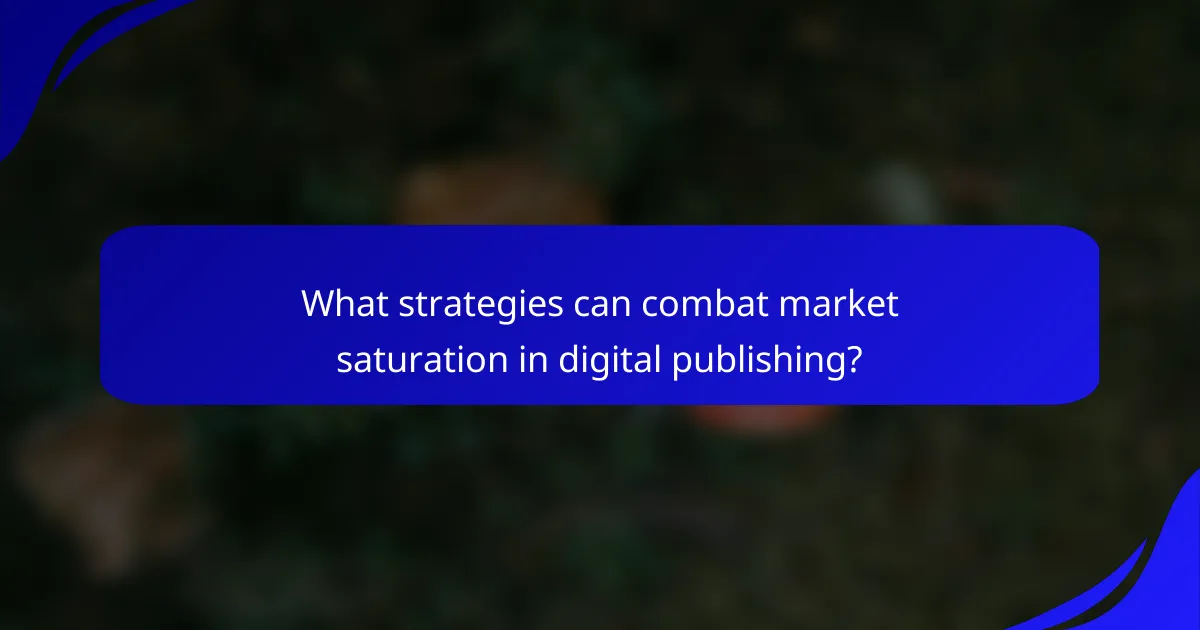Digital publishing faces significant challenges, including platform dependency, content piracy, and market saturation. To navigate these issues, creators can adopt strategies that enhance their control over distribution, protect their work from unauthorized use, and differentiate their offerings in a competitive landscape. By leveraging technology and data insights, publishers can effectively address these obstacles and establish a sustainable presence in the digital marketplace.

What are the solutions for platform dependency in digital publishing?
To address platform dependency in digital publishing, creators can adopt various strategies that enhance their control and flexibility. These solutions include utilizing multiple platforms, implementing content syndication, and leveraging open-source tools, among others.
Utilizing multiple publishing platforms
Using multiple publishing platforms allows content creators to reach diverse audiences and mitigate risks associated with relying on a single platform. By distributing content across various channels, publishers can enhance visibility and engagement.
Consider platforms like Medium, WordPress, and social media sites. Each has unique audiences and features, which can be leveraged to maximize content impact. However, managing multiple accounts requires careful coordination to maintain a consistent brand voice.
Implementing content syndication strategies
Content syndication involves sharing your content on third-party sites to increase exposure and drive traffic back to your primary platform. This approach can significantly broaden your audience and enhance brand recognition.
When implementing syndication, choose reputable sites within your niche to maintain credibility. Ensure that you retain control over your original content by using canonical tags to prevent SEO issues. Regularly assess the performance of syndication efforts to optimize results.
Adopting open-source publishing tools
Open-source publishing tools provide flexibility and customization, reducing dependency on proprietary platforms. These tools allow publishers to build tailored solutions that meet their specific needs without vendor lock-in.
Examples include WordPress.org and Joomla, which offer extensive plugins and themes. While open-source tools require some technical knowledge, they can be cost-effective in the long run, especially for those looking to create a unique user experience.
Leveraging cloud-based services
Cloud-based services offer scalability and accessibility, making them ideal for digital publishing. These services facilitate collaboration among teams and provide secure storage for content, reducing the risk of data loss.
Platforms like Google Drive and Dropbox enable easy sharing and editing of documents in real time. However, be mindful of data privacy regulations, especially if handling sensitive information, to ensure compliance with laws like GDPR.
Building a proprietary publishing platform
Creating a proprietary publishing platform allows complete control over content distribution and monetization strategies. This approach can enhance brand identity and foster a loyal audience base.
While developing a custom platform requires significant investment and technical expertise, it can yield long-term benefits. Consider factors such as user experience, scalability, and integration with marketing tools to ensure the platform meets your needs effectively.

How can content piracy be addressed in the UK?
Content piracy in the UK can be effectively addressed through a combination of technological measures, legal actions, and consumer education. By implementing strategies such as digital rights management and watermarking, alongside promoting subscription models, the industry can mitigate the impact of piracy.
Implementing digital rights management (DRM)
Digital rights management (DRM) involves using technology to control how digital content is used and distributed. This can include encryption methods that restrict access to authorized users only, making it more difficult for pirates to copy or share content illegally.
While DRM can protect intellectual property, it may also frustrate legitimate users who face restrictions on how they can use purchased content. Striking a balance between protection and user experience is crucial.
Utilizing watermarking technology
Watermarking technology embeds identifiable information into digital content, allowing publishers to trace pirated materials back to their source. This can deter potential infringers who know that their actions can be tracked.
Watermarks can be visible or invisible, and they do not typically affect the quality of the content. However, they may not prevent piracy entirely, as determined individuals can still attempt to remove or alter them.
Engaging in legal action against infringers
Taking legal action against those who infringe on copyright can serve as a strong deterrent. In the UK, copyright holders can pursue claims through the courts, seeking damages and injunctions against infringing parties.
While legal action can be effective, it can also be costly and time-consuming. Publishers should weigh the potential benefits against the resources required to pursue such actions.
Promoting subscription models
Subscription models can provide a steady revenue stream while offering consumers access to a wide range of content. By making content affordable and easily accessible, publishers can reduce the incentive for piracy.
Examples include platforms like Netflix or Spotify, which offer extensive libraries for a monthly fee. These models can create a loyal customer base and diminish the appeal of pirated alternatives.
Educating consumers about piracy impacts
Educating consumers about the negative impacts of piracy is essential for fostering a culture of respect for intellectual property. Awareness campaigns can highlight how piracy affects creators and the industry as a whole.
Engaging with audiences through social media, workshops, or informative content can help shift perceptions and encourage legal consumption of digital content. This grassroots approach can complement technological and legal strategies effectively.

What strategies can combat market saturation in digital publishing?
To combat market saturation in digital publishing, creators must implement strategies that distinguish their content and engage specific audiences effectively. By focusing on unique offerings and leveraging data insights, publishers can carve out a sustainable niche in a crowded market.
Differentiating content offerings
Differentiating content offerings involves creating unique, high-quality material that stands out from competitors. This can include exclusive interviews, in-depth analyses, or innovative formats like interactive storytelling. Publishers should regularly assess their content against industry trends to identify gaps and opportunities.
Consider incorporating multimedia elements such as videos or podcasts to enhance traditional written content. This diversification can attract a broader audience and increase retention rates.
Focusing on niche markets
Focusing on niche markets allows publishers to target specific audiences with tailored content. By understanding the unique needs and preferences of these groups, publishers can create specialized offerings that resonate more deeply than general content. Researching audience demographics and interests is crucial for identifying viable niches.
For example, a publisher might focus on eco-friendly living or local travel guides, appealing to audiences passionate about these topics. This targeted approach can lead to higher engagement and loyalty among readers.
Enhancing user engagement through interactivity
Enhancing user engagement through interactivity can significantly improve reader retention and satisfaction. Interactive elements such as quizzes, polls, and comment sections encourage users to participate actively rather than passively consuming content. This interaction fosters a sense of community and connection with the material.
Implementing features like live Q&A sessions or user-generated content can further boost engagement. These strategies not only keep readers involved but also provide valuable feedback for content improvement.
Utilizing data analytics for targeted marketing
Utilizing data analytics for targeted marketing enables publishers to understand audience behavior and preferences better. By analyzing metrics such as page views, time spent on content, and user demographics, publishers can refine their marketing strategies to reach the right audience effectively.
Tools like Google Analytics or social media insights can provide actionable data. Publishers should regularly review this information to adjust their content and promotional efforts, ensuring they remain relevant in a saturated market.
Collaborating with influencers and brands
Collaborating with influencers and brands can amplify a publisher’s reach and credibility. Partnering with individuals or companies that align with the publisher’s values can introduce the content to new audiences and enhance brand visibility. Influencers often have established trust with their followers, making their endorsements powerful.
When considering collaborations, it’s essential to choose partners whose audiences overlap with the target demographic. This strategic alignment can lead to mutually beneficial outcomes, driving traffic and engagement for both parties involved.

What are the key criteria for selecting a digital publishing platform?
When selecting a digital publishing platform, consider factors such as scalability, user experience, and monetization options. These criteria will help ensure that the platform meets your current needs while allowing for future growth and adaptability.
Assessing scalability and flexibility
Scalability refers to a platform’s ability to handle increased content volume and user traffic without performance issues. Look for platforms that offer flexible plans, allowing you to upgrade as your audience grows or your content expands.
Consider whether the platform supports various content types, such as text, video, and interactive media. This versatility can enhance user engagement and accommodate different publishing strategies.
Evaluating user experience and design
User experience (UX) is crucial for retaining readers and encouraging interaction. A well-designed platform should offer intuitive navigation, responsive design, and fast loading times to keep users engaged.
Test the platform’s customization options to ensure you can create a unique brand identity. A visually appealing layout that aligns with your content can significantly impact user retention and satisfaction.
Considering monetization options
Monetization options are essential for generating revenue from your digital content. Look for platforms that offer diverse methods such as subscriptions, advertising, and affiliate marketing to maximize your earning potential.
Evaluate the platform’s transaction fees and payment processing capabilities, as these can affect your overall profitability. Aim for platforms that provide transparent pricing and support multiple currencies to cater to a global audience.
